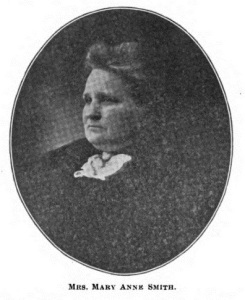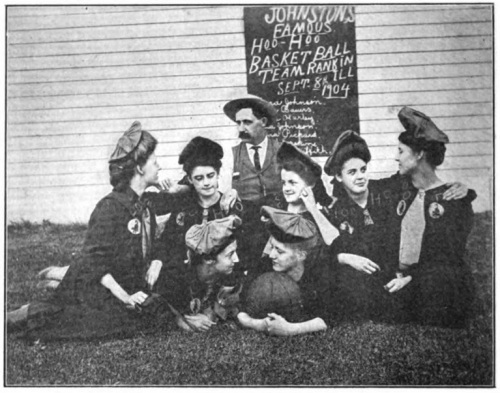Celebrating the Unconventional: A Brief History of Women in Hoo-Hoo
The September 1911 issue of The Bulletin, the old monthly journal of the International Concatenated Order of the Hoo-Hoo, had this to say:
Not a great many of our members realize that the Concatenated Order of Hoo-Hoo has one member who would not take offense if referred to as no gentleman. In the early days of the organization, and before there was incorporated into the constitution the provision that membership be confined strictly to men over twenty-one, there occurred a lumber convention and a concatenation at Memphis, Tennessee, on which occasion, the ceremonies being somewhat modified, a lady was duly initiated.
The fact that there is a woman member in the great Order of Hoo-Hoo is not so much a matter of wonder and speculation, as was the early life of this woman Hoo-Hoo, entering as she did into the business world at a time when woman and commercialism were but strangers.
The Hoo-Hoo in question was No. 2877, Mary Anne Smith. Mary Anne was born in Somerville, Tennessee, shortly before the Civil War. The Bulletin describes her early life as one of “hardship and suffering” as she grew up during the war and Reconstruction Period. “But,” the article notes, “no period, no matter how rife with struggle, hardship, and suffering, is without its romance, so in time young Mary Norman met and came to marry James Allen Smith—one of the pioneer names in Arkansas” in 1873.
Anne was born in Somerville, Tennessee, shortly before the Civil War. The Bulletin describes her early life as one of “hardship and suffering” as she grew up during the war and Reconstruction Period. “But,” the article notes, “no period, no matter how rife with struggle, hardship, and suffering, is without its romance, so in time young Mary Norman met and came to marry James Allen Smith—one of the pioneer names in Arkansas” in 1873.
They built a small business empire in Arkansas together, Mary Anne working “hand in hand with her husband” until his death in 1889. Upon his death she became president of the Smithton Lumber Company and vice president of the Southwestern Arkansas and Indian Territory Railroad. Her husband had begun operating this narrow-gauge railroad in 1885 to move lumber to market. She successfully operated it until the Panic of 1893, the worst economic depression in U.S. history until that time. The Bulletin states that “her property passed into the United States courts” and was forced out of her hands. “Mrs. Smith,” it says, stayed “in the business world, for her spirit remains indomitable and unabashed.”
 She did stay in the business world. Mary Anne Smith was concatted (meaning initiated) as Number 2877 into Hoo-Hoo on February 20, 1895, in Memphis. Her membership had been sponsored by three members, including one of the founders. In 1905 she moved her family to Searcy, Arkansas, and remained active in Hoo-Hoo the rest of her life, frequently hosting other Hoo-Hoos at her home as they passed through town. At the January 1912 meeting, she was one of 8 people who gave speeches. The Bulletin article recapping the 1911 meeting noted that Mrs. Smith had “the distinction of being the only woman who is now and has ever been a member of Hoo-Hoo.” This refrain typically appeared in articles mentioning she had attended a meeting.
She did stay in the business world. Mary Anne Smith was concatted (meaning initiated) as Number 2877 into Hoo-Hoo on February 20, 1895, in Memphis. Her membership had been sponsored by three members, including one of the founders. In 1905 she moved her family to Searcy, Arkansas, and remained active in Hoo-Hoo the rest of her life, frequently hosting other Hoo-Hoos at her home as they passed through town. At the January 1912 meeting, she was one of 8 people who gave speeches. The Bulletin article recapping the 1911 meeting noted that Mrs. Smith had “the distinction of being the only woman who is now and has ever been a member of Hoo-Hoo.” This refrain typically appeared in articles mentioning she had attended a meeting.
According to the organization’s own history, Mary Ann Smith was the first female Hoo-Hoo. When the 1911 article appeared, the fraternal organization of the lumber industry wasn’t yet formally closed to women members. Legend has it that other women gained membership over the years by using just their initials on the applications, not their first names. But there’s no way to confirm this. Yet some members were progressive enough to support women’s sports teams in the early 20th century.
So, what’s all this hullabaloo about the International Concatenated Order of the Hoo-Hoo about, you may ask. Hoo-Hoo had been established in Gurdon in 1892 to foster better relations among lumbermen and trade associations. The six men—a mix of lumbermen and writers working for trade journals—who would become the founders sat waiting for the next train when discussion turned to the lack of community and communication among the diverse business interests of lumbermen. “It was agreed that only one common interest existed within the complex web of industry concerns, that being goodwill and fellowship upon which lumbermen could come together in single mindedness and unity. The group agreed that lumbermen meeting on the grounds of good fellowship could receive intangible benefits that might eventually trickle down into all aspects of business and social relationships…” There were already plenty of fraternal lodges and formal business groups—in fact, the men were stuck waiting for a train in Gurdon while traveling between association meetings, a circumstance which led to this impromptu meeting.

Johnston’s Famous Hoo-Hoo Basketball Team, pictured here with sponsor Scott Johnston in 1904, called Rankin, Illinois, home. Johnston praised them as “a fine lot of girls and good players–every one of them.” The players were a mix of students and teachers, and the team dissolved when they returned to school in September of that year.
They quickly agreed that another conventional, stuffy group was not needed. “[It] was to be a war on conventionality,” replete with goofy titles for officers borrowed from a Lewis Carroll story, like calling the president the Grand Snark of the Universe, and parodying and mocking the rituals of Masons and other secret organizations. Underlying the humor, though, was a single, serious aim: “to foster the health, happiness, and long life of its members.” Unconventional it was, and it has remained, as this blog post can attest. (As can this author, who spoke at the 2014 annual convention. The genuine displays of fellowship and fun were impressive.) Many organizations do good deeds in the local community and help others following a disaster, but few have as much fun as the Hoo-Hoos.
Having a female member in the early days of the organization certainly made Hoo-Hoo unconventional in the male-dominated world of lumber. But that soon came to an end. When Mary Ann Smith died on July 25, 1926, at age 68, she was, officially, still the only female member. Not long after her passing, the bylaws were amended to provide only for males over age 21. For the next sixty years, women attended the conventions with their husbands but couldn’t join.
Little was done about this until the 1986 convention, when delegates first voted to remove the Eligibility clause from the bylaws. A proposal to do so was voted on every year after but failed to pass until 1993. In March of that year, the motion to amend the Hoo-Hoo International Bylaws to strike the word “male” from the Eligibility clause was again put forward. To be eligible you now only had to meet the age requirement and of course to “be of good moral character.” In seconding the motion, Royce Munderloh declared: “Tradition has played a big part in the debate concerning this issue. The world has changed greatly in the last 100 years, and many traditions have changed for the best.” And so the change was made. At the 101st international convention in 1993, with the by-laws revised to open membership to women, Beth Thomas, the executive secretary of Hoo-Hoo and manager of the Hoo-Hoo Museum in Gurdon, was the first woman accepted into the organization in this new era. She was concatted with two other women.
Other women joined the Hoo-Hoo organization through local chapters soon thereafter. In November 1993, another Mary—Mary O’Meara Moynihan—was concatted with the first group of women admitted into the Twin Cities Club. She’d been part of her family’s business for much of her life, so it made business sense for her to join. When asked in late 2011 what her goals in Hoo-Hoo were, she simply declared, “In 2013, I hope to become Snark”—leader of the of the worldwide Hoo-Hoo organization. She was only off by a few months with that prediction. In 2014, Mary became the first female Grand Snark of the Universe. Now in its 125th year, International Concatenated Order of the Hoo-Hoo is led by another woman, Robyn Roose Beckett. The unconventional organization is now conventional.

Grand Snark Robyn Beckett (center) with six new Hoo-Hoo members who were concatted at the 2016 convention. The diversity of ages and races found in this group is not unusual anymore either.

